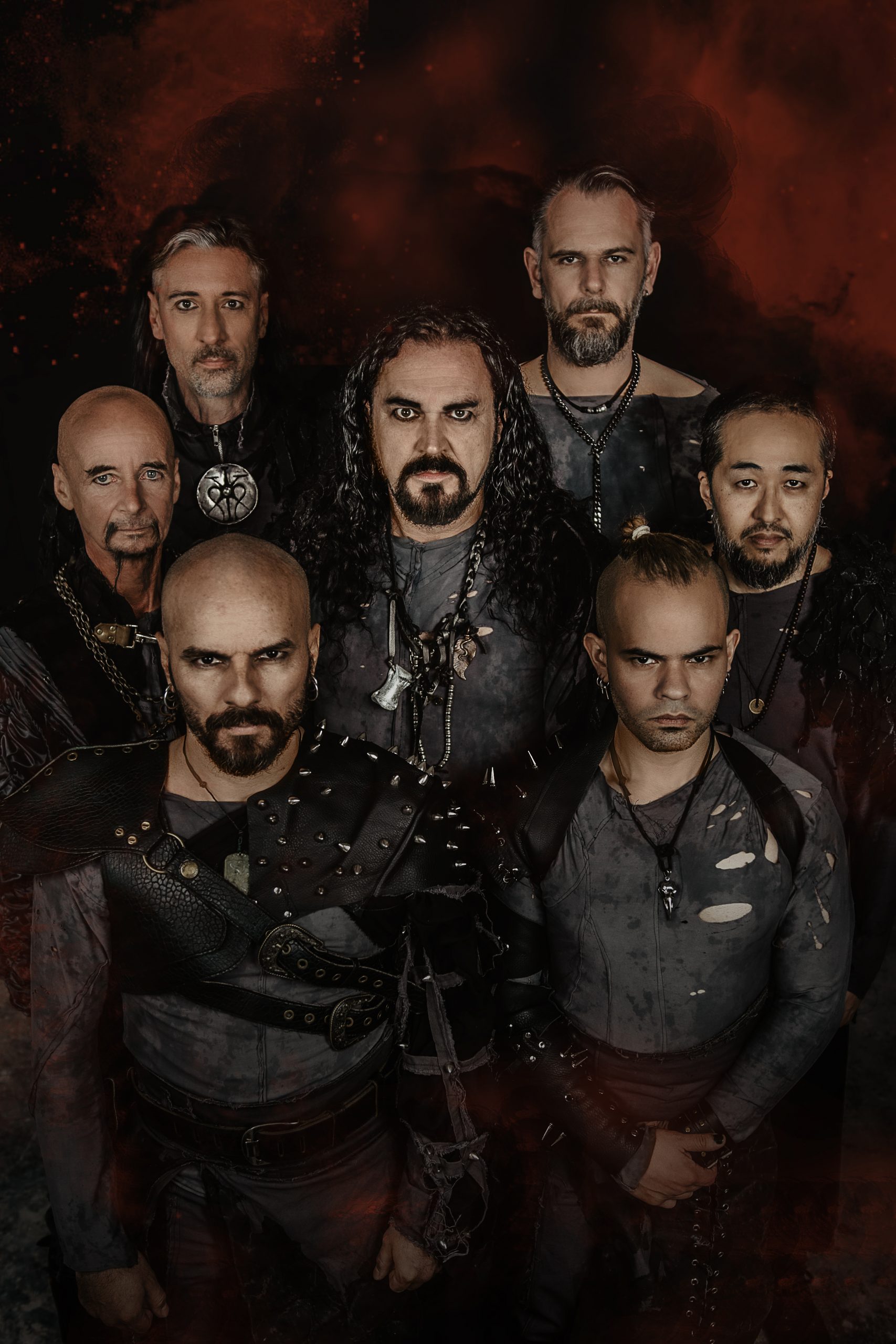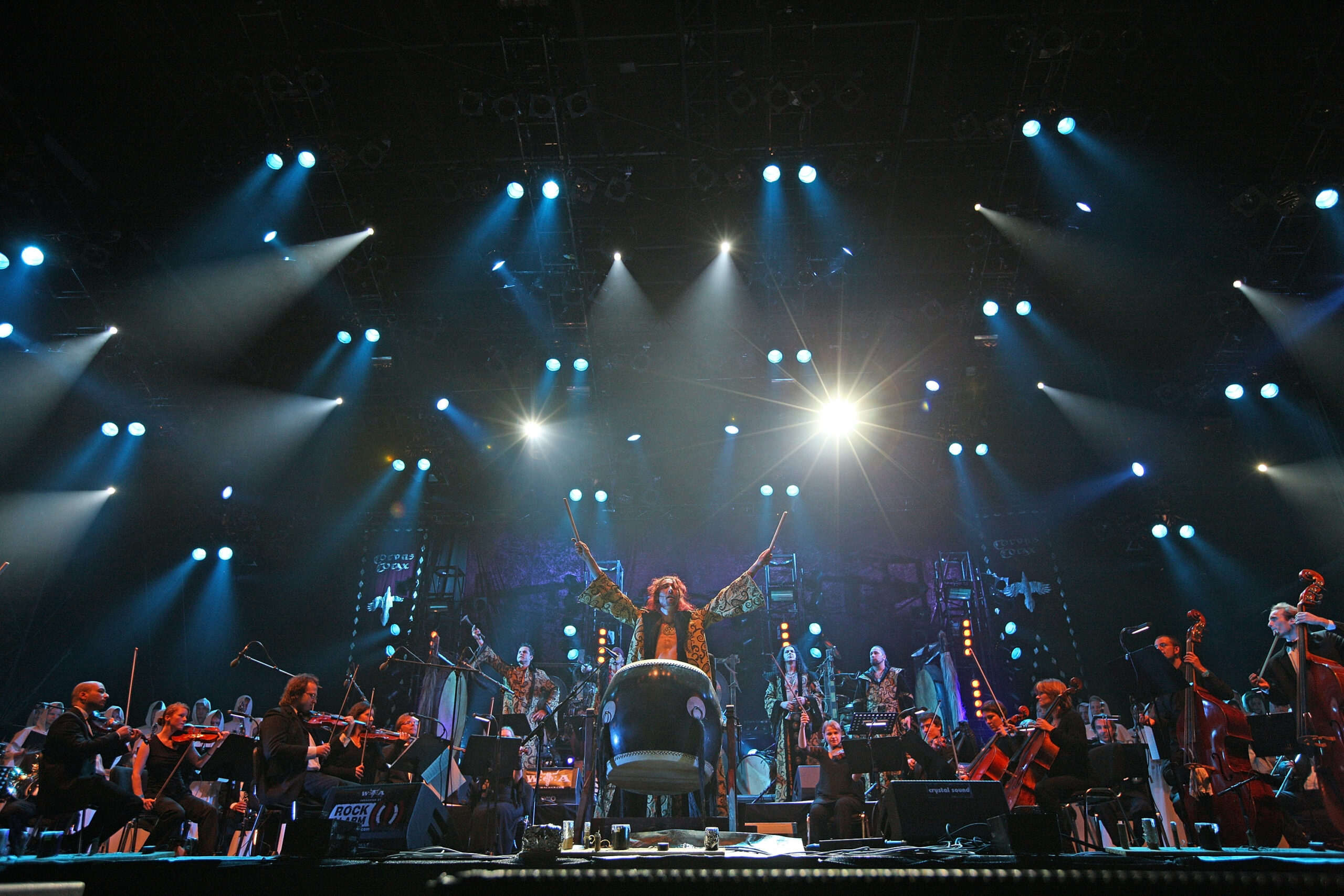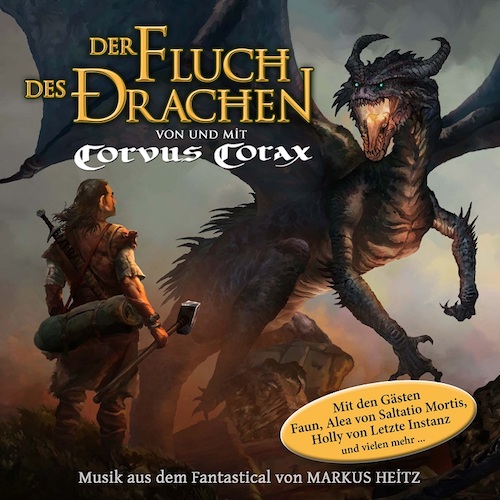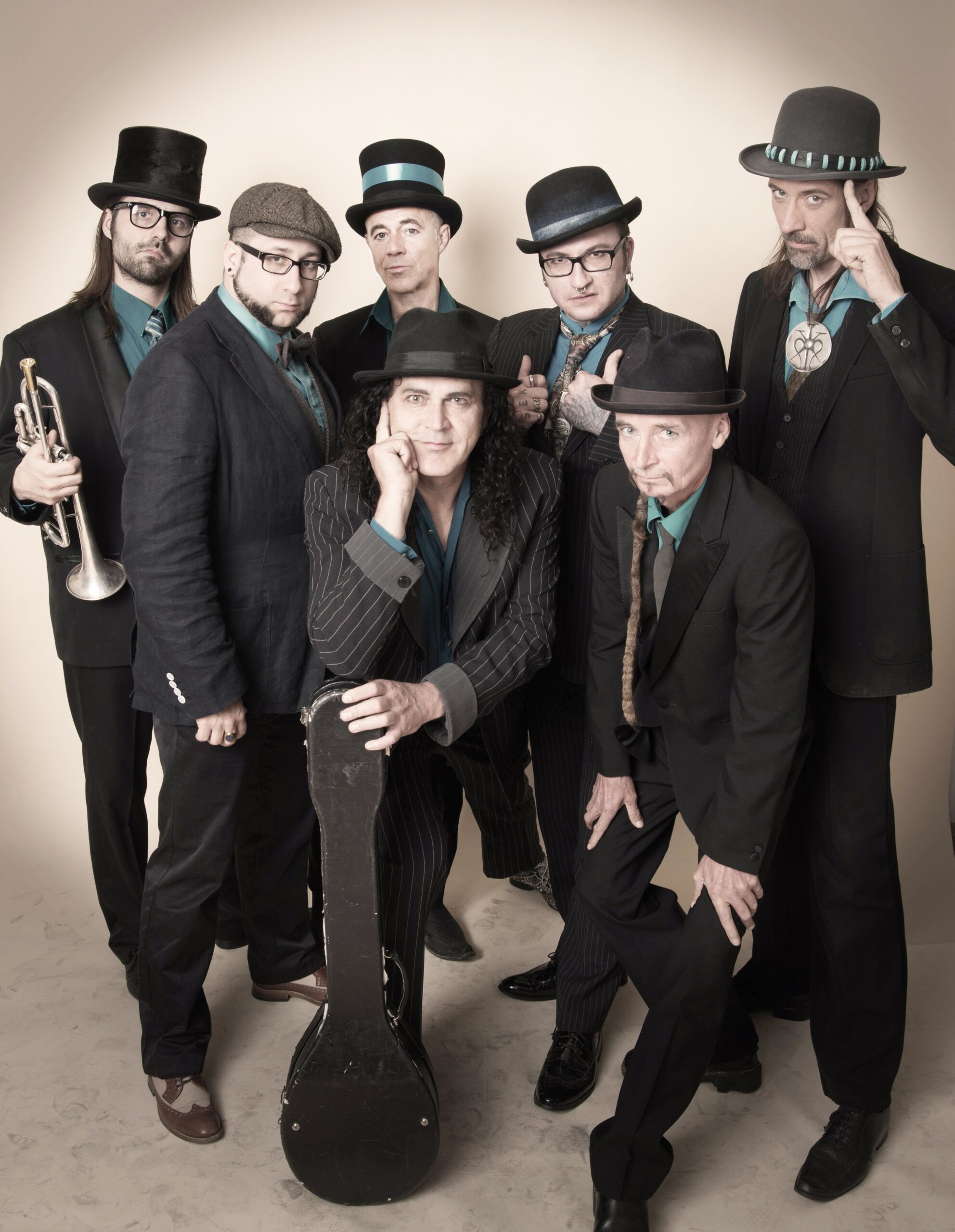Projects
The musicians of Corvus Corax have always been more than just a medieval band. In the tradition of medieval travelling musicians, they take up a wide variety of currents, styles and instruments and create something new with them. Here is an overview of the various projects
ERA METALLUM (since 2022)
Under the banner “ERA METALLUM”, CORVUS CORAX let it rip. On the double album to be released on 24 June 2022, reinforced by KREATOR’s Finnish guitar god Sami Yli-Sirniö and further guest appearances by seasoned metal greats, the masters of old instruments present a hand-picked selection of their most popular classics from the Nordic cultural sphere in a new steel sound garment.
“We just felt like playing heavy metal,” explains percussionist and drummer Norri, who many surely remember from his time with the cult metal band DEPRESSIVE AGE. So it’s no wonder that with “ERA METALLUM” CORVUS CORAX have conjured up a tough new combination of “metal board” and ancient instruments.
Whoever still expects this to be another so-called “medieval rock record” to happily sway along to will lose their methorn already with the opener. After a threatening intro, ‘Gjallarhorni’ resounds with an Asgard-shaking force and uncompromisingly shows where the musical journey to the far north is heading. Roaring horns, powerful choirs and several “old” instruments that deliver everything from melody to madness are combined with bass, drums and guitars in the best thrash and power metal tradition.
On the subject of “new”, the skalds can announce that CORVUS CORAX even provide a freshly recorded epic on “ERA METALLUM” with the dark ‘Víkingar’, cut exactly to size. It gets doubly exciting when CORVUS CORAX have the Icelandic opera singer Arndís Halla skilfully turn this number, which is bursting with testosterone, into its feminine counterpart in Valkyrie style on the second CD.
A similarly fascinating double treatment is given to the two Irish pieces ‘Na láma- sa’ and ‘Lá í mBealtaine’. The former is heavily roughed up in another version by Primordial frontman Alan “Nemtheanga” Averill, while the latter song is once again hymnally reinterpreted. BLIND GUARDIAN singer Hansi Kürsch, bassist Bill Gould (FAITH NO MORE) and guitarist Sonia Anubis from COBRA SPELL all contributed to this hit.
Of course, the Faroese hit ‘Sverker’ must not be missing from CORVUS CORAX’s set – as well as the ominous, heavy Odinsraben epic ‘Hugin & Munin’ or the swinging mermaid ‘Havfru’, who occasionally turns into a raging fury in the metalised new version. And when Sabina Classen from HOLY MOSES takes over the vocal part of ‘Ragnarök’, the end of the world sung about comes frighteningly close. Although the album works excellently even without knowledge of history, specialists will notice that CORVUS CORAX cover the entire Nordic cultural area including the Anglo-Saxon and Irish contact zone – and without any super-teaching attitude.
So it seems only logical that CORVUS CORAX finally dedicate themselves to their love of heavy metal with “ERA METALLUM”. As always, the musical alchemists succeed in transforming raw metal into pure gold! With “ERA METALLUM”, CORVUS CORAX deliver a full blast that will not only captivate headbangers.
The limited edition includes an exclusive bonus disc with the following guests: Hansi Kürsch (BLIND GUARDIAN), Bill Gould (Faith No more), Doro, Sabina Classen (Holy Moses), Alan Nemtheanga A. (PRIMODIAL), Arndis Halla, Philipp Bischoff (DAMNATION DEFACED) & Sonia Anubis (COBRA SPELL).

CANTUS BURANUS (since 2005)
further info at cantusburanus.net
In 2005, the Berlin group Corvus Corax achieved something extraordinary with their orchestral project “CANTUS BURANUS”. They tore the legendary medieval text collection Carmina Burana out of Carl Orff’s grip and created a completely new setting for bagpipes and drums, symphony orchestra, vocal soloists and choir.
Ancient traditions, medieval music, classical music and a contemporary attitude to life were brought together with force and passion to form a synthesis that not only broke down many external boundaries, but also dissolved the usual dimensions.
In the same year, Corvus Corax performed their orchestral composition for the first time with great success at the Wacken Open Air and on the culturally rich Museum Island in Berlin. Two years of exciting concerts followed, during which time the artists were already working on the sequel and in 2008 Cantus Buranus 2 was released. A mixture of songs from both works has been performed with great success ever since, and the journey even took them as far as China in November 2008.
It cannot be emphasised often enough – the Carmina Burana is not a creation of Carl Orff. It is a collection of texts from the 11th and 12th centuries, written down around 1230. Little is known about the exact origin of the texts. The original name “Codex Buranus” was only changed to “Carmina Burana” in 1847. The songs give a comprehensive impression of the everyday and intellectual life of the Middle Ages. But as soon as you take a closer look at the texts, you will be surprised to discover that the Middle Ages are only a stone’s throw away from the 21st century. Although people lived in completely different circumstances back then, they dragged themselves through life with the same problems as today.
One more reason for Corvus Corax to take on the extensive body of texts and continue their journey through the ages and expanses, whereby the choice of writings and their themes underlines the astonishing topicality of the medieval song texts.
In their choice of compositional means and instruments, Corvus Corax are anything but arbitrary. Multicultural hybrids at any price are not their thing. They are concerned with bringing together sounds in their logical geographical and historical extension from antiquity to the present.
The group knows exactly which fundus they can access and they exploit the horn to the hilt. The composition wins out over the programme. The musical realisation of the texts becomes much more dynamic, subtleties are better brought out, and the unbridled force of the pieces is sensitively cushioned. The sound acquires a depth and colourfulness that would have been unthinkable in the first part of “CANTUS BURANUS” in 2005. The group’s instrumentation was expanded again for the new recording. In addition to the new bagpipes already mentioned, taiko drums have been added, which once again expand the horizon of the ensemble in time and space, for taiko drums have existed in their present form for 3000 years. Cantus Buranus – this is once again the outbreak of the Middle Ages from monastic enclosure into the urban everyday life of today. The composers have succeeded here in creating a timeless masterpiece that will also captivate later generations as a musical milestone.

DER FLUCH DES DRACHEN (since 2017)
further info at www.derfluchdesdrachen.de
Perhaps not everyone can immediately picture something under the term, but it hits the nail on the head: The Curse of the Dragon combines the opulence of an energetic musical with the fantasy and drama of an epic fantasy story.
The gripping plot of the Fantastical comes from none other than Markus Heitz. With a total circulation of 4.6 million books (The Dwarves, Ulldart, etc.) and constant placements on the SPIEGEL bestseller list, Markus Heitz is one of the most popular fantasy authors in the country and has really put his heart into the Fantastical: The Curse of the Dragon is a mysterious fantasy story about honour and villainy, loyalty and betrayal, faith and power. In the end, it’s about the greatest adventure humans have ever had to face: The adventure of love.
The narrator of the story is the actor Johannes Steck. Steck has not only read numerous genre novels and series for audio books, but is also the narrator of the famous Kaltenberg Knights’ Tournament. For The Curse of the Dragon, he combines the enormous repertoire of his voice with equally extensive genre experience.
Musically, the exciting story is performed by the well-known medieval band Corvus Corax. Epic elements and sound collages reminiscent of atmospheric soundtracks meet authentic music from the actual Middle Ages here – and this in turn meets pop music structures and melodic arcs from the present day, the likes of which have never been heard from the band before. Corvus Corax have always been experimental: this is evident in their soundtracks for computer games, experiments with electronica, collaborations with choirs and symphony orchestras as well as in their collaboration with the famous film composer Hans Zimmer for a film soundtrack. The fact that they have launched a new genre with “Fantastical” is entirely fitting for the Kolkraben.
The album for The Curse of the Dragon was produced by Ingo Politz (formerly of Vallicon) and Marcus Gorstein.

BERLINSKIBEAT (since 2010)
20s, street music, Berlin: that’s BerlinskiBeat.
Seven Berlin musicians from four different countries.
The streets of Berlin are international; and so is Berlinski Beat reviving the 20s with international flair: Berlin classics with danceable rhythms, Balkan beats and Mariachi music. Whether in the clubs or on the streets: with this project, the cosmopolitan Berlin musicians transfer the maxims and lyrics of the Golden 20s into the present.
Live, the seven multifaceted characters in elegant turquoise and black inspire not only with their multicultural charm, but also with an impulsive stage show and extravagant instruments: Staged percussion instruments, an outstanding brass section and even bagpipes and shawms become modern indie pop instruments with a unique eye-catching effect.
On their albums, not only the relevant street hits are made presentable in a modern-international sound of the Berlin street. Current themes such as street music in the Ringbahn and construction trailer life are also musically processed and glorified in the style of the 20s street hits. A musical and thematic bridge between Berlin street and dance music: decadence and the present brought into harmony.
BerlinskiBeat are not only supported by one of the best-known German mRock musicians: Rodrigo González from “Die Ärzte” takes up the guitar as a guest on one song; they were even able to convince the Mexican music greats from “Panteon Roccoco” to contribute creatively.


